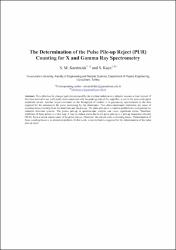The Determination of the Pulse Pile-up Reject (PUR) Counting for X and Gamma Ray Spectrometry
Access
info:eu-repo/semantics/closedAccessDate
2017Access
info:eu-repo/semantics/closedAccessMetadata
Show full item recordCitation
DOI:10.1063/1.4976408 :Alan endeksleri (The Conference Proceedings Citation Index (part of Web of Science)Scopus (Elsevier)InspecChemical Abstracts Service (CAS)Astrophysics Data System (ADS))Abstract
The collection the charged particles produced by the incident radiation on a detector requires a time interval. If this time interval is not sufficiently short compared with the peaking time of the amplifier, a loss in the recovered signal amplitude occurs. Another major constraint on the throughput of modem x or gamma-ray spectrometers is the time required for the subsequent the pulse processing by the electronics. Two above-mentioned limitations are cause of counting losses resulting from the dead nine and the pile-up. The pulse pile-up is a common problem in x and gamma ray radiation detection systems. The pulses pile-up in spectroscopic analysis can cause significant errors. Therefore, inhibition of these pulses is a vital step. A way to reduce en-ors due to the pulse pile-up is a pile-up inspection circuitry (PUR). Such a circuit rejects some of the pulse pile-up. Therefore, this circuit leads to counting losses. Determination of these counting losses is an important problem. In this work, a new method is suggested for the determination of the pulse pile-up reject.


















